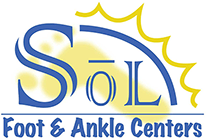
 Athlete's foot (tinea pedis) is a fungal infection that affects the skin of the feet. Fungal infections in the feet are very common and also highly contagious.
Athlete's foot (tinea pedis) is a fungal infection that affects the skin of the feet. Fungal infections in the feet are very common and also highly contagious.
Athlete’s foot can spread to the toenails causing toenail fungus (onychomycosis) and other areas of the body such as hands, groin, and underarms.
Symptoms of Athlete's Foot
The first signs and symptoms of athlete's foot is often itching between your toes or your feet itching at night. Other symptoms of athlete’s foot include scaling, redness, and burning between the toes and/or on the soles of the feet. You may have dry cracked skin on your feet or skin peeling between your toes.
Athlete’s foot on the bottom of the foot is often mistaken for dry skin. The skin usually appears dry or course, peeling, scaling and red. Between the toes the signs of athlete’s foot usually appear more red, inflamed, blistering, and or cracking of the skin. In severe case athlete's foot can also cause pain, redness and swelling.
Common Causes of Athlete's Foot
Athlete's foot is caused by a fungus. It likes to grow in dark, warm, moist environments and commonly attacks feet because shoes provide the perfect environment.
Fungus that causes athlete’s foot can be found at the gym, pool, shower, nail parlor, spa, hotels, and can spread through direct contact or contact with contaminated objects such as infected shoes, towels, workout equipment and floors.
Once the skin becomes infected the fungus begins to grow and multiply, possibly infecting other areas of the body.
Don’t ignore a fungal infection of the skin - it will not go away on its own.
Diagnosing the Problem- Exams and Tests
Your podiatrist may need to identify the type of fungus or yeast that is causing the skin infection. If tests are needed, they may include:
- Skin Culture
- KOH Exam
- Skin Biopsy
Treatment for Athlete's Foot
Treatment for athlete’s foot includes antifungal powders, sprays and creams. If you have the symptoms of athlete’s foot use an over-the-counter athlete's foot medicine (antifungal cream) on the soles of your feet and between your toes. Use the antifungal cream as directed. If you do not have improvement after 2 weeks seek help from a podiatrist.
Prescription strength creams obtained from your foot doctor are much better because they begin to kill the fungus almost immediately. It’s very important not to scratch the skin when there’s a fungal infection because scratching can spread the infecting organism to other areas.
Using the antifungal medication consistently is important for getting rid of your infection.
It’s also important to disinfect at home to prevent spreading the infection to other family members. Treat your shoes with an antifungal spray, or powder and disinfect your shower with bleach weekly until the infection is completely resolved.
Prevention
You can prevent common fungal infections such as athlete's foot by:
- Keep your feet dry. If you have sweaty feet change your socks twice a day.
- Use an antifungal and antibacterial shoe spray.
- Wash and dry your feet once a day.
- Avoid wearing shoes made out synthetic material such as rubber, plastics or vinyl.
- Wear shoes in public places.
- DO NOT share shoes.
Call Your Podiatrist right away if:
- You have diabetes or a compromised immune system and develop athlete's foot or suspect a fungal infection.
- Your foot is swollen and warm to the touch. If there are other signs of infection including drainage, pus or fever.
- Your symptoms do not resolve in 2-3 weeks with home treatment.
If you need help with your foot problem contact a foot specialist near you in Long Beach, CA, call 562-433-0478.
